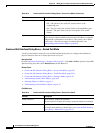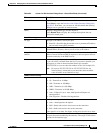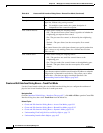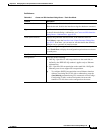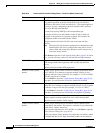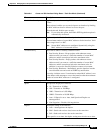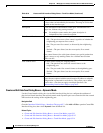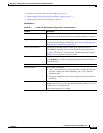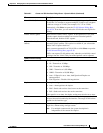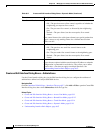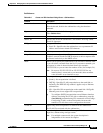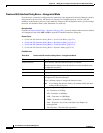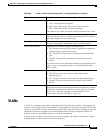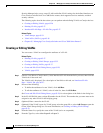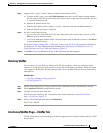
65-20
User Guide for Cisco Security Manager 4.4
OL-28826-01
Chapter 65 Managing Cisco Catalyst Switches and Cisco 7600 Series Routers
Interfaces
Encapsulation Select one of the following:
• DOT1Q—Specifies VLAN encapsulation on the trunk link, as
defined by the IEEE 802.1Q standard. Applies only to Ethernet
subinterfaces.
• ISL—Specifies ISL encapsulation on the trunk link. 10-Gigabit
Ethernet ports do not support ISL encapsulation.
• Negotiate—Specifies that the interface negotiates with the
neighboring interface to become either an ISL or 802.1Q trunk,
based on the configuration and capabilities of the neighboring
interface.
Tip To configure DOT1Q encapsulation on an Ethernet interface
without associating the VLAN with a subinterface, enter the
vlan-id dot1q command using CLI commands or FlexConfigs.
Configuring VLANs on the main interface increases the
number of VLANs that can be configured on the router.
Native VLAN (Select button) Enables you to select the Native VLAN to associate with this interface,
using the ID specified in the VLAN ID field. (If no VLAN ID is
specified for the Native VLAN, the default is 1.) This option applies to
you only if you are configuring a physical interface that is meant to
serve as an 802.1Q trunk interface.
You must first specify DOT1Q as the encapsulation type.
The Native VLAN of a trunk interface is the VLAN to which all
untagged VLAN packets are logically assigned. This includes the
management traffic associated with the VLAN.
When deselected, the Native VLAN is not associated with this
interface.
Note The Native VLAN cannot be configured on a subinterface of the
trunk interface. Be sure to configure the same Native VLAN
value at both ends of the link; otherwise, traffic may be lost or
sent to the wrong VLAN.
Click Select to open the VLAN Selector Dialog Box, page 65-36. From
here, you can associate a native VLAN with the described interface.
Allowed VLANs (Select
button)
Enables you to specify which VLANs are allowed on the trunk. Enter
the VLAN IDs. Use commas to separate multiple VLANs or use a
hyphen to indicate a range of VLANs (for example, 12,17,22 or 2-200).
Valid IDs range from 1 to 4094.
Alternatively, click Select to open the VLAN Selector Dialog Box,
page 65-36. From here, you can select the VLANs to include on the
trunk.
Table 65-7 Create and Edit Interface Dialog Boxes—Dynamic Mode (Continued)
Element Description



